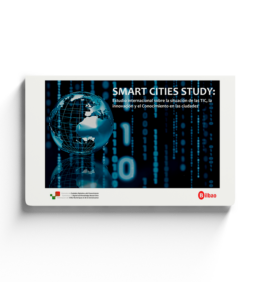
One of the main activities carried out by the Committee in 2012 has been the elaboration of the “Smart Cities Study: International study on the situation of ICT, innovation and Knowledge in cities”.
A work that we have developed with a lot of excitment and that represents a milestoe in the committee, since it is the first publication developed by the committee.
The last few decades have seen rapid development in information and communication technologies (ICTs), innovation and knowledge, which has increased their presence in day-to-day life and made them basic elements for the social and economic progress of territories.
Being aware of this tendency, from the Committee we have been working in 2012 in the developedment of the “Smart Cities Study: International study on the situation of ICT, innovation and Knowledge in cities” in which 28 cities form all over the world have collaborated.
A Study that makes a follow-up to the commitment acquired by the Local Authorities that took part in the II World Summit of Local Authorities on the Information Society held in 2005 in Bilbao for boosting the information society in their territories.
The world is becoming increasingly digital and no-one can afford to be left out of the changes taking place. This rapid change has given as a result a new model of city, the so called “Smart City“.
A city, that seeks to become more livable, functional, competitive and modern through the use of new technologies, the promotion of innovation and the management knowledge.
We talk about a “holistic” vision of Smart City, which brings together 6 key Areas of performance that affect the development of cities:
- Economy
- People
- Governance
- Mobility
- Environment
- Quality of life
It is important to remark that the Study does not seek to make a ranking of cities.
With this Study, from the Committee we want to provide a reference document for UCLG members that show the degree of progress made by the members in regards to ICT, innovation and knowledge, in each of the previously mentioned Areas.
Through the Study we analyse the information that was made available by the 28 cities, related to these 6 areas and the key factors that they include. This has allowed us to have a global vision of the situation of cities in each of the action fields, but also a vision at a regional level.
The Study also provides many best practices and experiences that will help to boost the knowledge-sharing between cities.
MAIN RESULTS
When we refer to “Smart Economy” we refer to a City with “smart” industries, especially, with industries in the field of information and communication technology (ICT), innovation, research and development, as well as other industries that involve ICT in their production processes.
This area includes key factors such as: the Penetration of ICT use in businesses, the economic promotion in cities, to retain and attract talent and promote creativity, the support for entrepreneurship, the creation of infrastructure to support business activities in their territories -such as Technology Parks, Industrial Parks, Scientific Parks and Business Incubators- and finally the internationalization.
Some of the main results of the Study:
| Penetration of ICT use in businesses | Increase in the number of companies that have computers and Internet connections, although there are differences between regions in Europe and Asia compared with Latin America and Africa. |
| Economic promotion | 75% of cities have a Local Development Agency. This trend however does not exist in African cities. Cities also promote sectors that are considered strategic, either by developing sectoral strategic plans or by promoting certain industries, especially those based on technology, innovation and creativity. |
|
Retaining and attracting talent and promoting creativity |
65% of cities have developed some kind of initiative to attract and retain talent in their territory, but this trend is more intense in Europe and Asia. |
|
Support for entrepreneurship |
68% of cities have developed some type of programme to support entrepreneurship in cities, except in Africa, where the number of cities that have developed such initiatives is very small. |
| Business spaces | Most part of the cities have infrastructures to support business activities in their territories, such as science or technology parks, industrial parks and business incubators. There is however a gap with cities in Africa. |
| Internationalization | 65% of cities have developed some sort of plan or strategy for the international promotion of the city. |
The differentiating element between a digital city and a smart city is Smart People. People are smart in terms of their skill and educational levels, as well as the quality of social interaction in terms of integration and public life and their ability to open to the “outside” world.
This area includes important factors such as: the education and training – the percentage of the population with higher education, the presence of the University in the city and the adaptation of the education offer to the labour market needs-, to boost and develop of e-Learning -through the design of digital development plans in classrooms, the use of ICT in education and the promotion of long-distance and virtual education-, the commitment towards the Life-long learning and the empowerment of Human Capital -by boosting the collaboration between companies and knowledge centres- and the support to Research, Development and Innovation (R&D&i).
Some of the main results of the Study:
| Education and Training |
67% of cities the Percentage of population with university degrees ranges between 0% and 25%, a trend that increases in European and Asian cities. 62% of Cities believe that the University has a strong presence in the city. 53% of cities believe that the education offered does not adapt to the demands of the current market. This percentage is particularly higher in Africa and Latin America. |
| e-Learning |
50% of cities have digital development plans for their schools is growing. 78% of cities the percentage of schools connected to the Internet is very high, ranging between 76% and 100%. However the percentage of teachers using new technologies for educational purposes, is relative small since, in most cities (46%) it is between 0% and 25%. 30% of cities have promoted some type of e-learning programme. |
| Life-long training | 60% of cities have implemented measures to promote lifelong learning. This trend can be seen mostly in European and Asian regions. |
| Human Capital | 68% of cities have developed some kind of cooperation between companies and knowledge centres, especially in Europe, Africa and Latin America. |
| R&D&i | Most cities dedicate a percentage of their revenue on R&D&i in their territories. The average percentage of revenue dedicated to R&D&i stands at 1.59%. |
Smart Governance includes political and active participation, citizenship services and the smart use of e-Government. In addition, it often relates to the use of new communication channels, such as e-government or “e-democracy”.
This area includes factors such as: Local Public spending on ICT, the availability of website, the development of Strategic plans to promote e-Government and ICT, the possibility to access to on-line public services, the commitment towards a more transparent government -through the publication of municipal information in the website-, and the e-Democracy -through the creation of on-line platforms for citizen participation and the availability of electronic voting- and finally the promotion of ICT and Innovation -by raising awareness and promoting the importance of ICT and Innovation among the public and businesses-.
Some of the main results of the Study:
| Local Public spending on ICT | The average percentage of Public spending on ICT in cities on the total budget stands at 3%. |
| Website availability | 93% of cities have web site as their main channel of communication with the public. |
| Strategic plans to promote e-Government and ICT | 64% of cities have developed an e-Government action plan. This proves that cities have sought to meet he commitment acquired in Bilbao Summit. |
| On-line public services | 64% of cities the percentage of public services that can be performed on-line in most cities is still small, ranging from 0% to 25% of the services offered by cities. Most popular on-line services: the possibility of filing complaints and claims, requesting certificates and reports, making payments and debits, on-line registrations and paying taxes and fees. 54% of cities offer the possibility of using electronic signatures for municipal procedures. |
| Transparent governance | Cities provide the public access to municipal information through their websites. The institutional information that is most frequently posted by cities refers to municipal plans, regulations and budgets. |
| e-Democracy | 62% of cities have some type of on-line platform for citizen participation; this trend can mostly be seen European and Asian cities. |
| Promoting ICT and Innovation | 46% of cities organize events related to ICT and innovation. |
Smart Mobility has to do with providing the public with access to new technologies, and the use of these in everyday urban life.
It includes the Connectivity and ICT infrastructure -with the percentage of Internet users, broadband or high-speed Internet territorial coverage, the percentage of the population subscribed to broadband services, the use of mobile phones as well as mobile internet- and the Public Internet Access -through the installation of Wi-Fi hotspots in the city, the creation of municipal spaces where computers with Internet connection are placed at the disposal of the public and the development of agreements with internet providers-.
Some of the main results of the Study:
| Connectivity and ICT infrastructure |
41% of cities have a high percentage of Internet users, ranging between 76% and 100%. 70% cities have between 76% and 100% of the municipal territory covered by broadband services. 40% of cities have a percentage of the population subscribed to broadband services between 76% and 100% . This trend can be seen especially in Europe and Asia. 62% of cities have a percentage high percentage of the population subscribed to mobile phone services between 76% and 100%. There has been an increase in the percentage of people who use mobile Internet services. |
| Public Internet Access |
More and more cities have Wi-Fi hotspots around town with the aim of extending the benefits of the Information Society to all citizens. Cities also provide municipal spaces where computers with Internet connection are placed at the disposal of the public. In some cases, cities have reached some kind of agreement with ISPs with a view to providing the public with the opportunity of subscribing a high-quality Internet connection at reasonable prices. |
The fifth Area involves the “Smart Environment” which refers to the use of new technologies to protect and preserve a city´s environment.
We talk about factors such as trust and security -through the implementation of ICT-based systems to improve citizen security – and the maintenance and strengthening of cultural identities -through the promotion of initiatives to digitize and share their cultural heritage-.
Some of the main results of the Study:
| Security and trust |
A growing number of cities have implemented systems to improve citizen security based on ICT.The main system used is video surveillance. New technologies are also used to improve computer systems with a view to managing incidents and emergencies. |
| Culture and identity | A growing number of cities have promoted some type of initiative to digitize and share their cultural heritage, especially in the cities of Asia and Europe. |
And last but not least, we find the sixth Area which refers to the “Smart Living” and that includes aspects that substantially improve the quality of life of citizens.
We talk most of all about the e-Health, and the use of new technologies in all the aspects that affect health care, from diagnosis to monitoring patients, including the management of the organisations involved in these activities. But we also talk about Accessibility and e-Inclusion, since ICT can enhance the capabilities of people with special needs, providing them with autonomy, independence and access to services that had not always been available to them. This is why the use of ICT should focus mainly on two objectives: solving deficiencies and enhancing capabilities.
Some of the main results of the Study:
| e-Health |
Through the use of new technologies, citizens can enjoy a number of on-line medical services, including key services such as requesting an appointment on-line or the possibility of having a digital record. However, the percentage of cities that offer such possibilities is still small. The percentage of cities that have some sort of electronic health card is also small. Cities in Europe and Asia are primarily starting to use this system. The number of cities that offer the possibility of accessing remote home services, alarm systems or remote patient monitoring systems is still limited. |
| Accessibility and e-Inclusion | More and more cities (52%) are driving digital inclusion programmes for groups at risk of exclusion. Such initiatives are conducted primarily in Asia and Europe, while the percentage of cities in Latin America and Africa that have introduced them is still small. |



